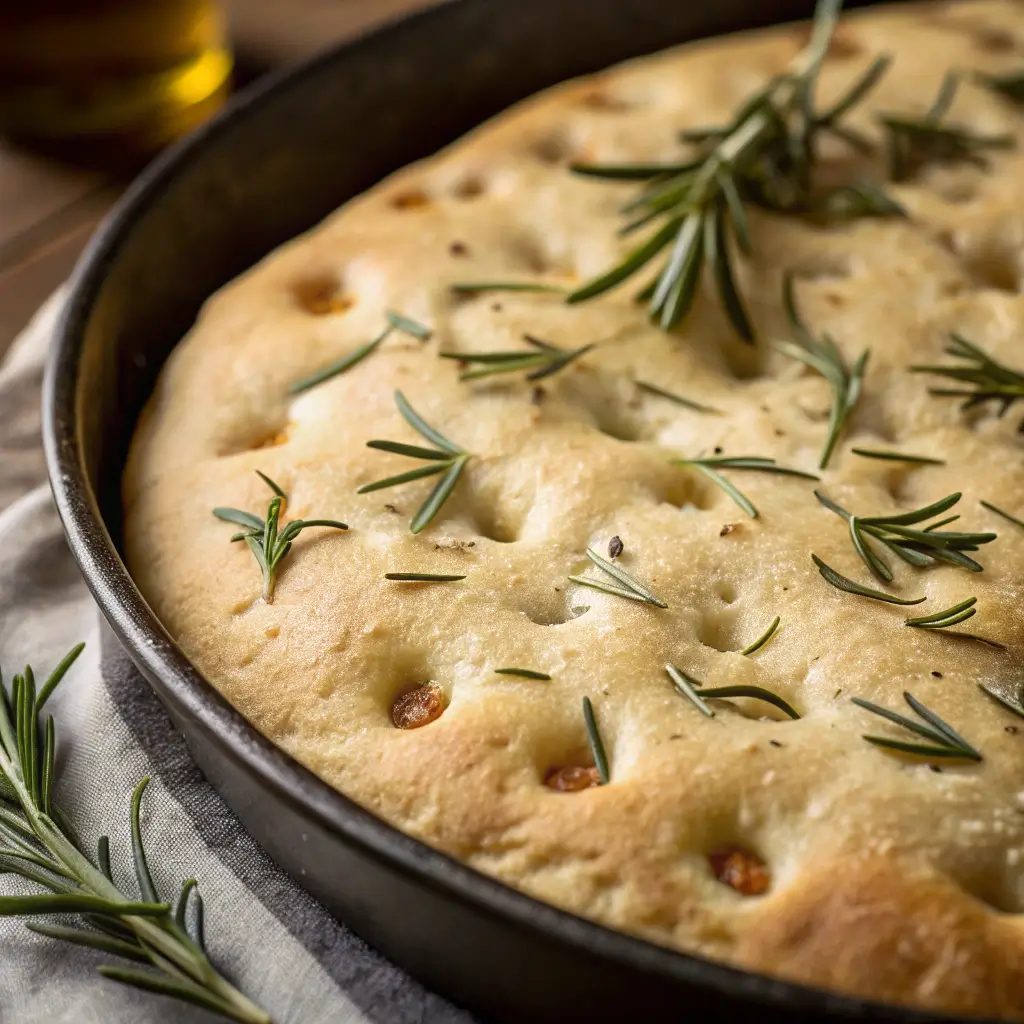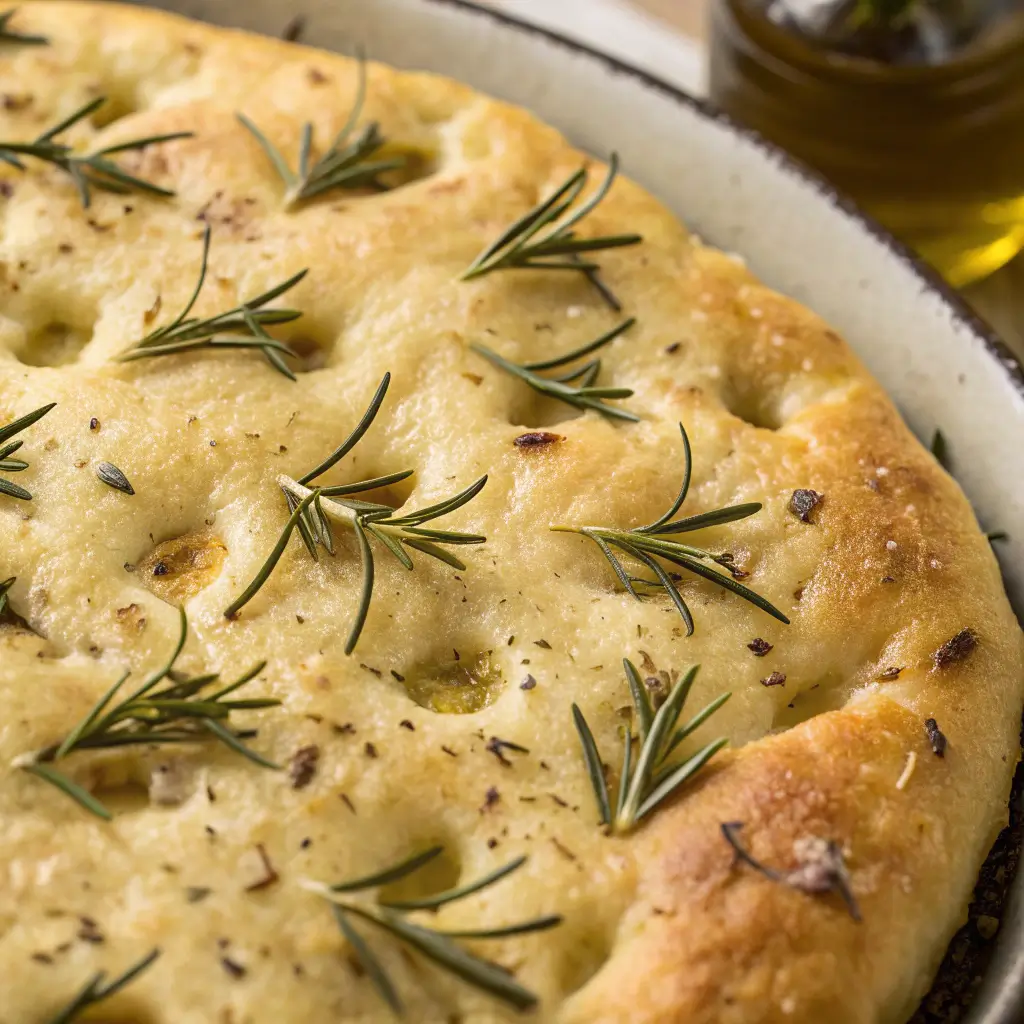Rosemary Focaccia Bread Recipe: Golden, Fluffy, and Full of Flavor
Introduction
Few breads are as versatile, fragrant, and crowd-pleasing as focaccia. With its golden crust, fluffy interior, and generous drizzle of olive oil, this Italian flatbread is the kind of recipe that transforms simple ingredients into something extraordinary. Add rosemary into the mix, and you elevate focaccia into a truly aromatic delight.
Rosemary focaccia is perfect for almost any occasion—whether as a starter for family dinners, sliced for sandwiches, served alongside soups and stews, or simply enjoyed on its own fresh from the oven. What makes this recipe even more appealing is that it’s surprisingly simple to make at home. With just flour, yeast, olive oil, and herbs, you can bake a loaf that rivals bakery quality.
This article will guide you through the entire process of making homemade rosemary focaccia bread, provide expert tips for the best texture and flavor, and share creative ways to serve and enjoy this Italian classic.

What Makes Focaccia Special?
Focaccia is one of Italy’s oldest breads, known for its flat shape, signature dimples, and rich olive oil flavor. Unlike standard sandwich bread, focaccia is baked with a generous coating of olive oil that soaks into the crust, giving it a chewy texture on the inside and a crisp, golden surface.
Rosemary is a traditional herb used in focaccia, not only for its bold flavor but also for the way it perfumes the bread during baking. Each bite bursts with earthy, herbal notes that balance perfectly with the bread’s soft chew and slight saltiness.
Ingredients You’ll Need
- 4 cups (480 g) all-purpose flour or bread flour
- 2 teaspoons salt
- 1 packet (2 ¼ teaspoons) instant yeast
- 1 ½ cups (360 ml) warm water (about 110°F / 43°C)
- ¼ cup (60 ml) extra virgin olive oil, plus more for drizzling
- 2 tablespoons fresh rosemary, chopped
- 1 teaspoon flaky sea salt (for topping)
Optional: Add-ins such as garlic, cherry tomatoes, olives, or caramelized onions for variation.
Equipment
- Large mixing bowl
- Wooden spoon or spatula
- Measuring cups and spoons
- Baking sheet or 9×13-inch pan
- Parchment paper
- Plastic wrap or kitchen towel
Step-by-Step Instructions
Step 1: Activate the Yeast
In a large bowl, mix the warm water and yeast. Let it sit for 5 minutes until slightly foamy. This step ensures the yeast is active and ready to help your dough rise.
Step 2: Mix the Dough
Add flour, salt, and 2 tablespoons of olive oil to the yeast mixture. Stir until a sticky dough forms. The dough should be soft and slightly tacky but not overly wet.
Step 3: Knead (or No-Knead Option)
For best results, knead the dough on a lightly floured surface for about 5–8 minutes until smooth and elastic. Alternatively, for a no-knead version, simply mix until combined and let the dough rise longer (overnight in the fridge works well).
Step 4: First Rise
Place the dough in a lightly oiled bowl, cover with plastic wrap or a towel, and let it rise at room temperature for 1–2 hours until doubled in size.
Step 5: Prepare the Pan
Line a baking sheet or 9×13-inch pan with parchment paper. Coat it generously with olive oil to prevent sticking and to give the focaccia its signature golden crust.
Step 6: Shape the Dough
Transfer the risen dough into the pan and gently press it out with your fingertips until it fills the space. Cover again and let rise for another 30–40 minutes.
Step 7: Create the Dimples
Once the dough has puffed up, drizzle 2 tablespoons of olive oil over the top. Use your fingers to press deep dimples all over the surface. These indentations help hold oil and toppings, creating pockets of flavor.
Step 8: Add Rosemary and Salt
Sprinkle chopped rosemary and flaky sea salt evenly over the surface. For extra flavor, press some of the herbs gently into the dough.
Step 9: Bake
Preheat oven to 425°F (220°C). Bake focaccia for 20–25 minutes until golden brown on top.
Step 10: Cool and Serve
Remove from the oven, let cool for at least 10 minutes, then slice into squares or strips. Enjoy warm or at room temperature.
Flavor and Texture Profile
- Crust: Crisp and golden with a rich olive oil sheen.
- Interior: Soft, fluffy, and slightly chewy with airy pockets.
- Flavor: Savory, earthy rosemary balanced by salt and olive oil richness.
Expert Tips for Success
- Use high-quality olive oil: Since olive oil is central to focaccia, choose one with a fruity, peppery flavor.
- Don’t skip the dimpling: Pressing the dough creates texture and helps toppings stay in place.
- Be generous with oil: It’s what makes focaccia unique—don’t be shy with drizzling.
- For crispier edges: Bake in a metal pan rather than glass.
- For deeper flavor: Let the dough ferment overnight in the refrigerator before baking.

Variations to Try
- Garlic Rosemary Focaccia – Add roasted garlic cloves for a sweet, earthy flavor.
- Tomato Basil Focaccia – Press halved cherry tomatoes into the dough and sprinkle with basil.
- Olive & Herb Focaccia – Add black or green olives for a Mediterranean twist.
- Cheese-Topped Focaccia – Sprinkle parmesan or mozzarella before baking for a savory upgrade.
- Caramelized Onion Focaccia – Spread caramelized onions over the dough for extra sweetness.
Serving Ideas
Rosemary focaccia is wonderfully versatile:
- Serve as an appetizer with balsamic vinegar and olive oil for dipping.
- Use as sandwich bread for paninis or veggie sandwiches.
- Pair with soups like creamy tomato, potato leek, or minestrone.
- Serve as a side with pasta, roasted chicken, or grilled vegetables.
- Toast and top with avocado, hummus, or ricotta.
Nutritional Snapshot (per slice, based on 12 servings)
- Calories: ~190
- Protein: 5 g
- Fat: 6 g
- Carbohydrates: 29 g
- Fiber: 1 g
Storage and Reheating
- Room Temperature: Store in an airtight container for up to 2 days.
- Freezer: Wrap slices individually and freeze for up to 2 months.
- To Reheat: Warm in the oven at 350°F (175°C) for 5–7 minutes to restore texture.
FAQs
Q: Can I make focaccia without rosemary?
Yes, rosemary is traditional but optional. You can swap in thyme, oregano, or sage.
Q: Can I make this gluten-free?
Yes, substitute with a gluten-free all-purpose flour blend, though texture will differ slightly.
Q: Why is my focaccia dense?
Most likely the dough didn’t rise long enough or the yeast wasn’t active. Always check your yeast and allow enough fermentation time.
Why You’ll Love This Recipe
Rosemary focaccia bread is the perfect combination of simplicity and flavor. It requires just a handful of ingredients, yet the results are restaurant-worthy. Whether enjoyed plain, dipped in olive oil, or used to elevate a meal, this bread is guaranteed to impress family and friends.
Conclusion
Making rosemary focaccia bread at home is one of the most satisfying kitchen projects you can try. With its golden crust, fluffy texture, and herbaceous flavor, it brings the heart of Italian baking right into your kitchen. The process is simple, the ingredients are accessible, and the outcome is nothing short of spectacular.
So next time you’re craving homemade bread, skip the ordinary loaf and opt for focaccia—it’s a bread that’s as beautiful as it is delicious.
